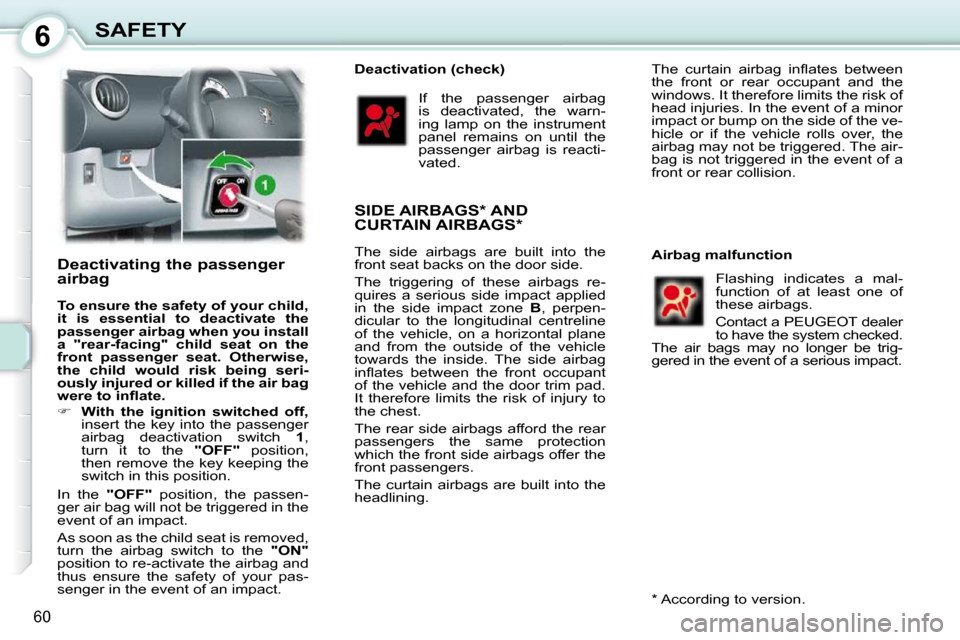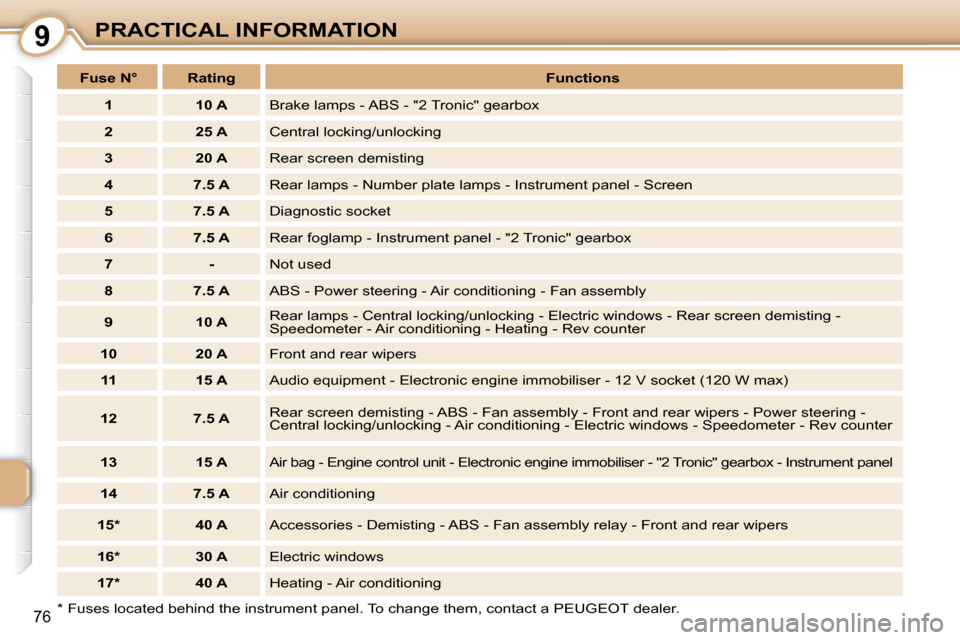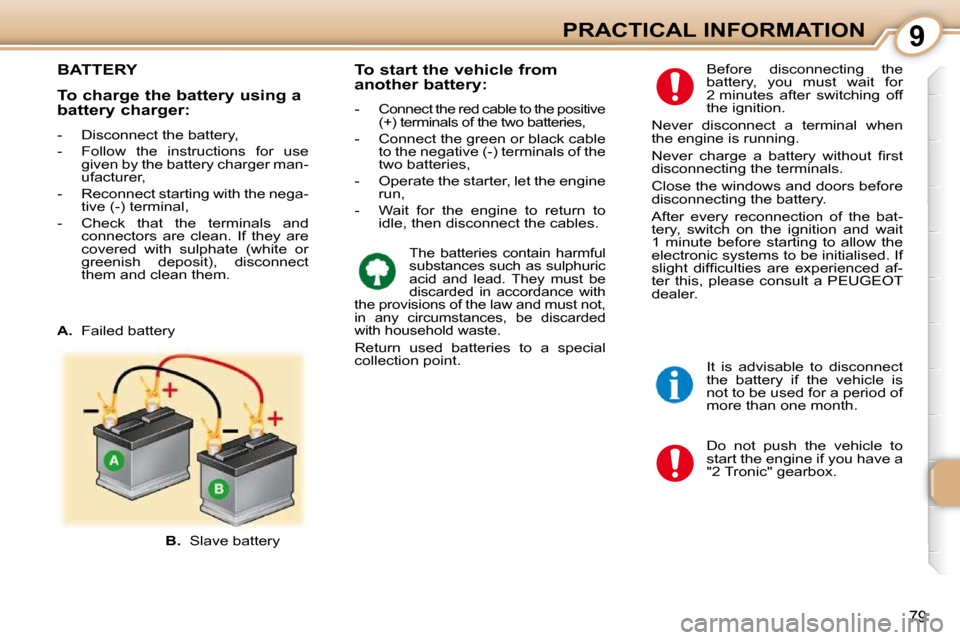2009 Peugeot 107 Dag window
[x] Cancel search: windowPage 51 of 99

4
48
ACCESS ELECTRIC
WINDOWS
The driver and front passenger each
have an electric window.
After the ignition has been switched
on, press or pull control 1 . The window
stops when you release the control.
Always remove the key from
the ignition when leaving
the vehicle, even for a short
time.
The driver must ensure that the front
passenger uses his electric window
correctly.
Be aware of children when operating
the windows.
DOORS
Simultaneous central locking/unlocking of the doors and boot.
To lock/unlock the vehicle, press/pull button A on the driver's door.
For the other doors, carry out the same operation as for normal locking/unlocking.
Driver's door open
If the driver's door is open,
the courtesy lamp remains
on if the button is in this posi-
tion.
Locking/unlocking a door
from the inside
Normal locking/unlocking: the doors
lock/unlock independently.
To lock/unlock a door, press/pull button A .
Note: operating the handle does not
unlock the door, pull button A to un-
lock.
Page 52 of 99

4
49
ACCESS
CHILD LOCK
This prevents the opening of each of
the rear doors from the inside.
Push control 1 towards the outside of
the vehicle.
LOCKING/UNLOCKING THE BOOT USING THE KEY*
To open, operate the lock B using the
key and raise the tailgate.
LOCKING/UNLOCKING THE BOOT USING THE REMOTE CONTROL *
The boot is locked/unlocked using
the buttons on the remote control.
Then, to open, press button C and
raise the tailgate.
Note: the boot can be locked/un-
locked using control A on the driver's
door.
REAR WINDOWS(5-DOOR)
To partially open the rear windows,
pull the lever then push the window.
To close the window, pull then press
the lever to lock the window.
Check the status of this safety
device before switching on the
ignition.
This system is independent
of the central locking.
Always remove the key from the igni-
tion when leaving the vehicle. * According to version.
Page 53 of 99

4
49
ACCESS
CHILD LOCK
This prevents the opening of each of
the rear doors from the inside.
Push control 1 towards the outside of
the vehicle.
LOCKING/UNLOCKING THE BOOT USING THE KEY*
To open, operate the lock B using the
key and raise the tailgate.
LOCKING/UNLOCKING THE BOOT USING THE REMOTE CONTROL *
The boot is locked/unlocked using
the buttons on the remote control.
Then, to open, press button C and
raise the tailgate.
Note: the boot can be locked/un-
locked using control A on the driver's
door.
REAR WINDOWS(5-DOOR)
To partially open the rear windows,
pull the lever then push the window.
To close the window, pull then press
the lever to lock the window.
Check the status of this safety
device before switching on the
ignition.
This system is independent
of the central locking.
Always remove the key from the igni-
tion when leaving the vehicle. * According to version.
Page 66 of 99

6
60
SAFETY
Deactivating the passenger
airbag
To ensure the safety of your child,
it is essential to
deactivate
the
passenger
airbag
when you install
a "rear-facing" child seat on the
front passenger seat. Otherwise,
the child would risk being seri-
ously injured or killed if the air bag
�w�e�r�e� �t�o� �i�n�fl� �a�t�e�.
� With the ignition switched off
, insert the key into the passenger
airbag deactivation switch 1 ,
turn it to the "OFF" position,
then remove the key keeping the
switch in this position.
In the "OFF" position, the passen-
ger air bag will not be triggered in the
event of an impact.
As soon as the child seat is removed,
turn the airbag switch to the "ON"
position to re-activate the airbag and
thus ensure the safety of your pas-
senger in the event of an impact. If the passenger airbag
is deactivated, the warn-
ing lamp on the instrument
panel remains on until the
passenger airbag is reacti-
vated.
� �T�h�e� �c�u�r�t�a�i�n� �a�i�r�b�a�g� �i�n�fl� �a�t�e�s� �b�e�t�w�e�e�n�
the front or rear occupant and the
windows. It therefore limits the risk of
head injuries. In the event of a minor
impact or bump on the side of the ve-
hicle or if the vehicle rolls over, the
airbag may not be triggered. The air-
bag is not triggered in the event of a
front or rear collision.
Flashing indicates a mal-
function of at least one of
these airbags.
Contact a PEUGEOT dealer
to have the system checked.
The air bags may no longer be trig-
gered in the event of a serious impact.
Deactivation (check)
Airbag malfunction
* According to version.
SIDE AIRBAGS * AND CURTAIN AIRBAGS *
The side airbags are built into the
front seat backs on the door side.
The triggering of these airbags re-
quires a serious side impact applied
in the side impact zone B , perpen-
dicular to the longitudinal centreline
of the vehicle, on a horizontal plane
and from the outside of the vehicle
towards the inside. The side airbag
�i�n�fl� �a�t�e�s� �b�e�t�w�e�e�n� �t�h�e� �f�r�o�n�t� �o�c�c�u�p�a�n�t�
of the vehicle and the door trim pad.
It therefore limits the risk of injury to
the chest.
The rear side airbags afford the rear
passengers the same protection
which the front side airbags offer the
front passengers.
The curtain airbags are built into the
headlining.
Page 68 of 99

6
60
SAFETY
Deactivating the passenger
airbag
To ensure the safety of your child,
it is essential to
deactivate
the
passenger
airbag
when you install
a "rear-facing" child seat on the
front passenger seat. Otherwise,
the child would risk being seri-
ously injured or killed if the air bag
�w�e�r�e� �t�o� �i�n�fl� �a�t�e�.
� With the ignition switched off
, insert the key into the passenger
airbag deactivation switch 1 ,
turn it to the "OFF" position,
then remove the key keeping the
switch in this position.
In the "OFF" position, the passen-
ger air bag will not be triggered in the
event of an impact.
As soon as the child seat is removed,
turn the airbag switch to the "ON"
position to re-activate the airbag and
thus ensure the safety of your pas-
senger in the event of an impact. If the passenger airbag
is deactivated, the warn-
ing lamp on the instrument
panel remains on until the
passenger airbag is reacti-
vated.
� �T�h�e� �c�u�r�t�a�i�n� �a�i�r�b�a�g� �i�n�fl� �a�t�e�s� �b�e�t�w�e�e�n�
the front or rear occupant and the
windows. It therefore limits the risk of
head injuries. In the event of a minor
impact or bump on the side of the ve-
hicle or if the vehicle rolls over, the
airbag may not be triggered. The air-
bag is not triggered in the event of a
front or rear collision.
Flashing indicates a mal-
function of at least one of
these airbags.
Contact a PEUGEOT dealer
to have the system checked.
The air bags may no longer be trig-
gered in the event of a serious impact.
Deactivation (check)
Airbag malfunction
* According to version.
SIDE AIRBAGS * AND CURTAIN AIRBAGS *
The side airbags are built into the
front seat backs on the door side.
The triggering of these airbags re-
quires a serious side impact applied
in the side impact zone B , perpen-
dicular to the longitudinal centreline
of the vehicle, on a horizontal plane
and from the outside of the vehicle
towards the inside. The side airbag
�i�n�fl� �a�t�e�s� �b�e�t�w�e�e�n� �t�h�e� �f�r�o�n�t� �o�c�c�u�p�a�n�t�
of the vehicle and the door trim pad.
It therefore limits the risk of injury to
the chest.
The rear side airbags afford the rear
passengers the same protection
which the front side airbags offer the
front passengers.
The curtain airbags are built into the
headlining.
Page 87 of 99

9
76
PRACTICAL INFORMATION
* Fuses located behind the instrument panel. To change them, contact a PEUGEOT dealer.
Fuse N° Rating
Functions
1 10 A Brake lamps - ABS - "2 Tronic" gearbox
2 25 A Central locking/unlocking
3 20 A Rear screen demisting
4 7.5 A Rear lamps - Number plate lamps - Instrument panel - Screen
5 7.5 A Diagnostic socket
6 7.5 A Rear foglamp - Instrument panel - "2 Tronic" gearbox
7 - Not used
8 7.5 A ABS - Power steering - Air conditioning - Fan assembly
9 10 A Rear lamps - Central locking/unlocking - Electric windows - Rear scree
n demisting -
Speedometer - Air conditioning - Heating - Rev counter
10 20 A Front and rear wipers
11 15 A Audio equipment - Electronic engine immobiliser - 12 V socket (120 W max)
12 7.5 A Rear screen demisting - ABS - Fan assembly - Front and rear wipers - Powe
r steering -
Central locking/unlocking - Air conditioning - Electric windows - Speedometer - Rev counter
13 15 A
Air bag - Engine control unit - Electronic engine immobiliser - "2 Tronic" gearbox - Instrument panel
14 7.5 A Air conditioning
15 * 40 A Accessories - Demisting - ABS - Fan assembly relay - Front and rear wipe rs
16 * 30 A Electric windows
17 * 40 A Heating - Air conditioning
Page 90 of 99

9
79
PRACTICAL INFORMATION
BATTERY
Do not push the vehicle to
start the engine if you have a
"2 Tronic" gearbox.
Before disconnecting the
battery, you must wait for
2 minutes after switching off
the ignition.
Never disconnect a terminal when
the engine is running.
� �N�e�v�e�r� �c�h�a�r�g�e� �a� �b�a�t�t�e�r�y� �w�i�t�h�o�u�t� �fi� �r�s�t�
disconnecting the terminals.
Close the windows and doors before
disconnecting the battery.
After every reconnection of the bat-
tery, switch on the ignition and wait
1 minute before starting to allow the
electronic systems to be initialised. If
�s�l�i�g�h�t� �d�i�f�fi� �c�u�l�t�i�e�s� �a�r�e� �e�x�p�e�r�i�e�n�c�e�d� �a�f�-
ter this, please consult a PEUGEOT
dealer.
To start the vehicle from
another battery:
- Connect the red cable to the positive
(+) terminals of the two batteries,
- Connect the green or black cable to the negative (-) terminals of the
two batteries,
- Operate the starter, let the engine run,
- Wait for the engine to return to idle, then disconnect the cables.
It is advisable to disconnect
the battery if the vehicle is
not to be used for a period of
more than one month.
The batteries contain harmful
substances such as sulphuric
acid and lead. They must be
discarded in accordance with
the provisions of the law and must not,
in any circumstances, be discarded
with household waste.
Return used batteries to a special
collection point.
To charge the battery using a
battery charger:
- Disconnect the battery,
- Follow the instructions for use
given by the battery charger man-
ufacturer,
- Reconnect starting with the nega- tive (-) terminal,
- Check that the terminals and connectors are clean. If they are
covered with sulphate (white or
greenish deposit), disconnect
them and clean them.
A. Failed battery
B. Slave battery